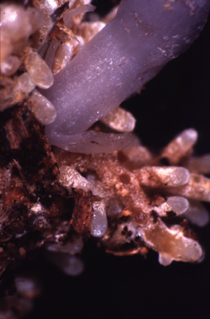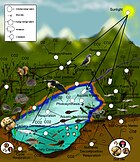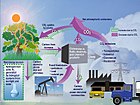
| Home | Sources Directory | News Releases | Calendar | Articles | | Contact | |
Myco-heterotrophy

Myco-heterotrophy is a symbiotic relationship between certain kinds of plants and fungi, in which the plant gets all or part of its food from parasitism upon fungi rather than from photosynthesis. A myco-heterotroph is the parasitic plant partner in this relationship. Myco-heterotrophy is considered a kind of cheating relationship and myco-heterotrophs are sometimes informally referred to as "mycorrhizal cheaters". This relationship is sometimes referred to as mycotrophy, though this term is also used for plants that engage in mutualistic mycorrhizal relationships.
Contents |
[edit] Relationship between myco-heterotrophs and host fungi
Full (or obligate) myco-heterotrophy exists when a non-photosynthetic plant (a plant largely lacking in chlorophyll or otherwise lacking a functional photosystem) gets all of its food from the fungi that it parasitizes. Partial (or facultative) myco-heterotrophy exists when a plant is capable of photosynthesis, but parasitizes fungi as a supplementary food supply. There are also plants, such as some orchid species, that are non-photosynthetic and obligately myco-heterotrophic for part of their life cycle, and photosynthetic and facultatively myco-heterotrophic or non-myco-heterotrophic for the rest of their life cycle.[1] Not all non-photosynthetic or "achlorophyllous" plants are myco-heterotrophic ' some non-photosynthetic plants like dodder directly parasitize the vascular tissue of other plants.[2]
In the past, non-photosynthetic plants were mistakenly thought to get food by breaking down organic matter in a manner similar to saprotrophic fungi. Such plants were therefore called "saprophytes". It is now known that no plant is physiologically capable of direct breakdown of organic matter and that in order to get food, non-photosynthetic plants must engage in parasitism, either through myco-heterotrophy or direct parasitism of other plants.[3][4]
The interface between the plant and fungal partners in this association is between the roots of the plant and the mycelium of the fungus. Myco-heterotrophy therefore closely resembles mycorrhiza (and indeed is thought to have evolved from mycorrhiza),[3] except that in myco-heterotrophy, the flow of carbon is from the fungus to the plant, rather than vice versa.[5][6]
Most myco-heterotrophs can therefore be seen as ultimately being epiparasites, since they take energy from fungi that in turn get their energy from vascular plants.[3][4][7] Indeed, much myco-heterotrophy takes place in the context of a common mycorrhizal network, in which plants use mycorrhizal fungi to exchange carbon and nutrients with other plants.[4] In these systems, myco-heterotrophs play the role of "mycorrhizal cheaters", taking carbon from the common network, with no known reward.[3]
In congruence with ancient reports, it has been recently shown that some myco-heterotrophic orchids can be supported by saprotrophic fungi, exploiting litter- or wood-decaying fungi.[8] In addition, several green plants (evolutionarily close to myco-heterotrophic ones) have been shown to be able to take carbon from their mycorrhizal fungi, that adds up to their photosynthesis (partial myco-heterotrophy).[9][10]
[edit] Species diversity of myco-heterotrophs and host fungi
Myco-heterotrophs are found among a number of plant groups. All monotropes and non-photosynthetic orchids are full myco-heterotrophs, as is the non-photosynthetic liverwort Cryptothallus. Partial myco-heterotrophy is common in the Gentian family with a few genera such as Voyria being fully myco-heterotrophic, in photosynthetic orchids, and a number of other plant groups. Some ferns and clubmosses have myco-heterotrophic gametophyte stages.[1][4][11] The fungi that are parasitized by myco-heterotrophs are typically fungi with large energy reserves to draw on, usually mycorrhizal fungi, though there is some evidence that they may also parasitize parasitic fungi that form extensive mycelial networks, such as Armillaria.[4]
[edit] Plant Families (with relevant myco-heterotrophic genera)
* Afrothismia - 3 species * Apteria - 1 species * Burmannia - 60 species * Campylosiphon - 1 species * Dictyostega - 1 species * Gymnosiphon - 50 species * Hexapterella - 2 species * Thismia - 28 species
* Arachnitis - 1 species * Corsia - 20 species * Corsiopsis - 1 species
Iridaceae, formerly Geosiridaceae (Asparagales)
* Geosiris - 1 species
This list only concerns species that are leafless, i.e. or are
losing photosynthetic function.
* Aphyllorchis - 15 species * Corallorhiza - 15 species * Cymbidium - 1 species * Cyrtosia - 5 species * Cystorchis - 8 species * Cephalanthera - 1 species * Didymoplexis - 10 species * Epipogium - 3 species * Eulophia - 1 species * Galeola - 10 species * Gastrodia - 35 species * Hexalectris - 7 species * Lecanorchis - 20 species * Limodorum - 1 species * Neottia - 9 species * Pterostylis - (as yet, unresolved number) * Rhizanthella - 2 species * Stereosandra - 1 species * Stigmatodactylus - 4 species * Wullschlaegelia - 2 species * Yoania - 2 species
Peterosaviaceae, also called Melanthiaceae
* Petrosavia - 2-4 species * Protolirion - 2 species
Triuridaceae (Pandanales), Including
* Lacandonia - 1 species * Sciaphila - 31 species * Triuris - 3 species
Pyroleae (partially myco-heterotrophic apart from Pyrola
picta ssp. aphylla)
* Chimaphila - 4-5 species * Monoses - 1 species * Orthilia - 1 species * Pyrola - 35 species
* Allotropa - 1 species * Hemitomes - 1 species * Monotropa - 1 (very variable) species * Monotropastrum - 4 species * Monotropsis - 1 species * Pityopus - 1 species * Pleuricospora - 2 species
* Pterospora - 1 species * Sarcodes - 1 species
* Bartonia - 3-4 species * Cotylanthera - 4 species * Obolaria - 1 species * Voyria (including Leiphaimos). 20 species * Voyriella - 2 species
* Salomonia (= Epirhixanthes) - 8 species
[edit] References
- ^ a b Leake JR. 1994. The biology of myco-heterotrophic ('saprophytic') plants. New Phytologist 127: 171'216. Warning: large document
- ^ Dawson JH, Musselman LJ, Wolswinkel P, Dörr I. 1994. Biology and control of Cuscuta. Reviews of Weed Science 6: 265'317.
- ^ a b c d Bidartondo MI. 2005. The evolutionary ecology of myco-heterotrophy. New Phytologist 167: 335'352.
- ^ a b c d e Leake JR. 2005. Plants parasitic on fungi: unearthing the fungi in myco-heterotrophs and debunking the 'saprophytic' plant myth. Mycologist 19: 113'122. (abstract)).
- ^ Trudell SA, Rygiewicz PT, Edmonds RL. 2003. Nitrogen and carbon stable isotope abundances support the myco-heterotrophic nature and host-specificity of certain achlorophyllous plants. New Phytologist 160: 391'401.
- ^ Bidartondo MI, Burghardt B, Gebauer G, Bruns TD, Read DJ. 2004. Changing partners in the dark: isotopic and molecular evidence of ectomycorrhizal liaisons between forest orchids and trees. Proceedings of the Royal Society of London, series B 271: 1799'1806.
- ^ Selosse M-A, Weiss M, Jany J, Tilier A, 2002. Communities and populations of sebacinoid basidiomycetes associated with the achlorophyllous orchid Neottia nidus-avis (L.) L.C.M. Rich. and neighbouring tree ectomycorrhizae. Molecular Ecology 11: 1831-1844.
- ^ Martos F, Dulormne M, Pailler T, Bonfante P, Faccio A, Fournel J, Dubois M-P, Selosse M-A. 2009. Independent recruitment of saprotrophic fungi as mycorrhizal partners by tropical achlorophyllous orchids. New Phytologist 184: 668-681.
- ^ Gebauer G, Meyer M. 2003. 15N and 13C natural abundance of autotrophic and myco-heterotrophic orchids provides insights into nitrogen and carbon gain from fungal association. New Phytologist 160: 209-223.
- ^ Selosse M-A, Roy M. 2009. Green plants eating fungi: facts and questions about mixotrophy. Trends in Plant Sciences 14: 64-70.
- ^ Taylor DL, Bruns TD, Leake JR, Read DJ. 2002. Mycorrhizal specificity and function in myco-heterotrophic plants. In: The Ecology of Mycorrhizas (Sanders IR, van der Heijden M, eds.), Ecological Studies vol. 157, pp 375'414. Berlin: Springer-Verlag. (NOTE: this PDF is from the page proofs, and is not identical to the published version)
[edit] Further reading
- Hershey DR. 1999. Myco-heterophytes and parasitic plants in food chains. American Biology Teacher 61: 575'578.
- Hibbett DS. 2002. When good relationships go bad. Nature 419: 345'346.
- Werner PG. 2006. Myco-heterotrophs: hacking the mycorrhizal network. Mycena News 57(3): 1,8.
- Dr. Martin Bidartondo: Selected publications
- D. Lee Taylor Lab: Recent Publications
- M.-A. Selosse's publications
[edit] External links
- The Strange and Wonderful Myco-heterotrophs The Parasitic Plant Connection, SIU Carbondale, College of Science.
- Wayne's Word Noteworthy Plant For June 1997: Fungus Flowers ' Flowering Plants that Resemble Fungi by WP Armstrong.
- Fungus of the Month for October 2002: Monotropa uniflora by Tom Volk, TomVolkFungi.net
- Martín's Treasure Chest ' images of myco-heterotrophs by mycologist Martín Bidartondo.
|
SOURCES.COM is an online portal and directory for journalists, news media, researchers and anyone seeking experts, spokespersons, and reliable information resources. Use SOURCES.COM to find experts, media contacts, news releases, background information, scientists, officials, speakers, newsmakers, spokespeople, talk show guests, story ideas, research studies, databases, universities, associations and NGOs, businesses, government spokespeople. Indexing and search applications by Ulli Diemer and Chris DeFreitas.
For information about being included in SOURCES as a expert or spokesperson see the FAQ . For partnerships, content and applications, and domain name opportunities contact us.


